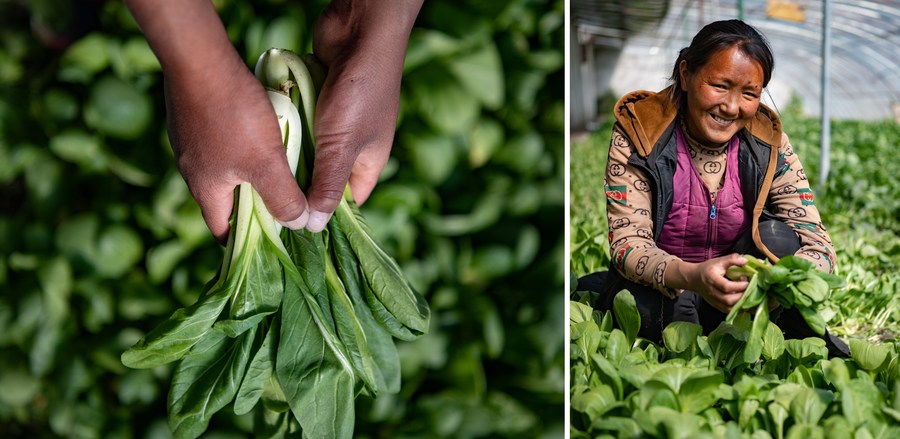
File photo shows the view of Khesum in the city of Shannan in Tibet Autonomous Region, southwest China. (Xinhua/Yu Gang)
Khesum, a village in Tibet, a forerunner in the region's democratic reform, completely obliterated feudal serfdom six decades ago. For the villagers, life today is beyond their wildest dream.
LHASA, Jan. 20 (Xinhua) -- As beams of winter sunlight shone down on the Yarlung River valley, Khesum, the local community, lit up with expectation about the upcoming Tibetan and Chinese new year festivals.
Bathed in the warm sunlight on the second floor of his home, Sonam Dondrup, 78, was preparing for the return of his grandchildren, who attend university outside the region.

Sonam Dondrup waters the plants at home in Khesum in the city of Shannan, Tibet Autonomous Region, southwest China on March 20, 2018. (Xinhua/Yu Gang)
Located in Changzhu Township in the city of Shannan in Tibet Autonomous Region, southwest China, Khesum pioneered Tibet's democratic reform decades ago. It changed the lives of the local community beyond recognition.
According to the neighborhood committee of Khesum, today, the local annual per capita income exceeds 22,000 yuan (about 3,400 U.S. dollars), 111 times as much as that in 1978.
Although life in Khesum has been bright for a long time, images of its dark past are still vivid to those once classed as serfs, including Sonam.
"I got up to work before sunrise every day. I would be whipped if I was late," said Sonam, adding that one of his fellow villagers' father was whipped to death by the serf owner.

In this combo photo, the upper file photo shows an elderly man begging on a street in Lhasa in Tibet Autonomous Region, southwest China before the peaceful liberation of the region; the lower part shows a group of pensioners celebrating Mid-Autumn Festival at a nursing home in Shannan, Tibet, on Sept. 14, 2016. (Xinhua)
Before the democratic reform, Khesum was one of six manors in Shannan that were ruled by Surkhang Wangchen Geleg, an official of then Tibetan local government.
Sonam was one of 302 serfs who lived in the village. He recalled that his family of nine slept on the ground with the livestock, clad in rags and choked on the smell of cow manure.
Just like Sonam, serfs in Tibet could barely afford land rent. They were forced to work, and often took on high-interest loans to pay for their daily necessities. In 1959, the grain yield in Khesum declined to 80 kilograms per mu (0.067 hectares). The same year, the democratic reform began in ernest and completely obliterated feudal serfdom of theocracy across the region.

In this combo photo, the left file photo shows a handcuffed serf, restrained to stop him from escaping, in Tibet Autonomous Region, southwest China, before the democratic reform; the top right part is a villager in Shannan in Tibet Autonomous Region taking a selfie with a smartphone on March 16, 2019; the bottom right part shows a herder from Damxung County taking part in a horse racing festival on Sept. 1, 2008. (Xinhua)
In June 1959, Sonam and others in Khesum elected the preparatory committee for the first association of villagers in Tibet. The first community-level branch of the Communist Party of China and the first people's commune of Tibet also began life here.
Later, emancipated serfs burned the land title and welcomed a new, free life.
That was genuine liberation, said Sonam.
As the incentive to work increased and the government helped to create social cohesion, Khesum's agricultural output skyrocketed. Some farmers teamed and shared livestock and farm tools. From 1959 to 1963, one team of farmers in Khesum doubled their grain output and dairy cattle herd.

Combo photo shows a villager from Khesum harvesting vegetables in a greenhouse in the city of Shannan in Tibet Autonomous Region, southwest China, on March 12, 2020. (Xinhua/Purbu Zhaxi)
Reform and opening up in the 1980s further boosted Khesum's development. The first villager who made 10,000 yuan and bought a truck made by Chinese state-owned automobile manufacturer Dongfeng was a descendant of serfs. Another villager, Dawa Tsering, funded a well-known rice noodle factory, helping the local community by creating new jobs.
In recent years, Khesum has witnessed more development.
Thanks to around 40 million yuan from the government, Khesum has not only modernized its drainage, lighting and afforestation systems, but also set up social initiatives, including a service center, a library and an entertainment center.

A villager from Khesum cleans his car in the city of Shannan in Tibet Autonomous Region, southwest China, on March 27, 2018. (Xinhua/Chogo)
Today, the farm mechanization rate is 98 percent, octupling the grain yield per mu in the village from pre-democratic reform levels.
Moreover, non-agricultural industries such as transportation, services and processing now account for over 80 percent of Khesum's total rural economy income, which exceeds 38 million yuan.
"Every day in the past, I wasn't sure whether I could survive to see the next day," said Sonam. "At that time, I didn't dare to dream of having a life like I live today." ■




